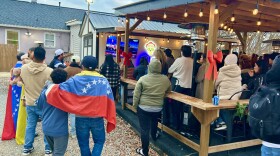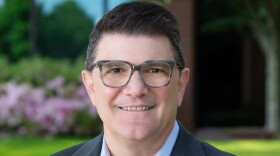When Chinese American artist Isabel Lu was a child growing up in Greensboro in the early 2000s, she’d accompany her parents on regular trips to Grand Asia Market — a grocery store in Raleigh roughly an hour and a half from where she lived.
“We didn’t have an Asian supermarket," Lu said. "So, my parents would drive the 90 minutes to come here and we would do like $200 worth of groceries every three to four weeks."
Lu, 25, recalled how her parents would come to Grand Asia to buy ingredients for hot pot, Asian greens, snow peas, daikon and lotus root. Some items, specifically tofu, bean sprouts and ginger, have become the subject of her colorful oil paintings, which this year have displayed at Durham Art Guild, City Market Artist Collective and Contemporary Art Museum Raleigh.
When Lu studied public health and nutrition in college and graduate school, she said that the Asian grocery items she grew up eating were left out of a very Western curriculum.
“The only pictures of healthy food was of the Mediterranean diet,” she said. “You kind of just get in your head that if I want to be healthy, I need to be eating olive oil and kale and you just kind of forget that your entire culture has so much variety and health.”
Asian American artists like Isabel Lu have produced work in the South for decades but they’ve become much more visible in recent years, whether it’s oil paintings in a gallery, or murals painted along the sides of restaurants and public transit buses.

Hong-An Truong, a Vietnamese American artist and director of UNC-Chapel Hill’s Graduate Studies in Studio Art, said that she’s observed a distinct increase in attention for Asian American artists in recent years.
“This question of Asian American and Asian art visibility in the South has been on my mind for a long time because in surveys of southern art, Asian Americans are not represented when it comes to themes about what it means to be southern," Truong said. “Unfortunately, the rise over the last three years of the COVID pandemic, of violence against Asians and Asian Americans in the U.S., has really forced a spotlight on racism and really deep rooted stereotypes and narratives around Asians in the US — that has ignited both a response from Asian Americans and Asian American artists.”
That aligns with Isabel Lu, who said that the rise of anti-Asian violence during the pandemic and the 2021 Atlanta Spa shootings, motivated her to pursue painting more seriously. When Lu received her master’s degree from UNC-Chapel Hill’s Gillings School of Public Health, she decided that instead of continuing on to a doctorate program, she would pursue painting as a way to explore her perspectives on food and nutrition, as well as sexual and gender identity. Lu herself identifies as asexual, or ace.
“I’m still very much interested in community health and like healthy food systems. But around the time of the Atlanta shootings, it kind of clicked to me that there’s a lot of racial inequities in our system, and I was getting back into painting,” she said. “I felt like art and painting is a way to communicate things and to me, it felt more natural. I didn’t think there was a lot of mentorship and structure in place for me to explore those things within the confines of academia.”
A curator who wants to open doors for Asian American artists
Partly what’s bringing more Asian American art into galleries across North Carolina is an increase in curators of color, said Hong-An Truong.
“Just from my vantage point, I can see a distinct sea change with those curatorial positions and those curators of color, say at North Carolina Museum of Art and Southeastern Center for Contemporary Art, recognizing the vastly diverse landscape of what might be constituted as regionally southern art,” Truong said.
In late September, the Southeastern Center for Contemporary Art opened an exhibition, If These Walls Could Talk, featuring the works of three artists of color, including Durham-based Thai American artist Raj Bunnag. The 38-year-old creates extremely detailed print murals that he said are partly inspired by the long, sprawling murals that he had seen at Buddhist temples when he briefly lived in Thailand in the mid-2000s. His murals show brutal depictions of the war on drugs, law enforcement and white supremacy.
His murals — which are on display at SECCA through Dec. 31 — are plastered onto three different walls. He pointed to one, which he described as “a giant racist poop bag.”
“He has the floppy KKK hood, he's holding a Bible, but he has his hand over his heart. He's pledging allegiance, he's in a suit. But he has his entrails coiled around his legs,” Bunnag said. “I’ve heard my friends describe it as terrifyingly goofy. Some of my favorite artists are survivors of the Holocaust. They make work that is incredibly dark, but there is a lightness or a humor to it. Because it’s what people use to acknowledge trauma.”
Bunnag was inspired to draw monsters because of his father, a mechanic who also drew as a hobby. Among the murals at SECCA, there’s a bull, based on his father’s last drawing.
“I call it the Jungle Asian Reject,” Bunnag said. “My father was a much better artist than me. He could draw me anything, whether it’s an eight-headed dragon with no legs, and he could draw creatures and monsters with such precision.”
However, Bunnag said that his father did not have the means to pursue art as a career. And Bunnag himself struggled for years to receive approval from his parents, who wanted him to become a doctor or an engineer. In 2022, he became the curator of exhibitions at CAM Raleigh.
“I feel like what I’m doing now as an artist and in my position as a curator is to show people like me that you don't have to be a doctor,” he said. “You don't have to be a dentist, scientist, engineer, whatever — you can pursue things, your passions that make you happy because you can make a living from it. It takes a bit more work, but it's possible.”

An Asian American might have painted that mural you pass by every day
Like Bunnag, Mayanthi Jayawardena, 34, is familiar with the parental pressure of choosing a career in healthcare. She has a master's degree in public health and worked in sexual violence prevention.
“Painting just seemed like the natural thing that I was drawn to,” said Jayawardena, who is a second generation Sri Lankan American. “I started having coworkers over and I would give everyone canvases and we would paint and have wine. And then I started finding myself doing that more on my own and the pieces that I was painting became more and more personal to me and what I was going through.”
Around the beginning of the COVID-19 pandemic, Jayawardena left her job in higher education to pursue art full-time and started her business, Serendib Creative. Her art consists of a wide range of forms, including children’s book illustrations, photography, clothing design, and murals. Her murals, which tend to contain vivid colors and flowers, can be found in many locations across the Triangle, including the back wall of Chapel Hill Public Library and a barrier at Conlon Family Skatepark in Raleigh.
“When I think of Sri Lanka, my favorite memories are just of the sunsets and the beautiful flowers and the fruit and everything that is just so vibrant,” Jayawardena said.
Jayawardena moved to the Triangle just before the pandemic, and while she’s been finding many opportunities, she wishes it was easier to connect with other Asian American artists. She also said she’d like to see more financial and institutional support for Asian American artists like her, especially from the greater North Carolina art community.

“I can't assume that everyone knows about my culture, and that everyone wants to know, but I do believe that art is a great connector,” she said. “And I think that people can still see themselves in my art and through a lot of all every single other Asian American artists. And I think that there's so much power in celebrating our communities.”
UNC-Chapel Hill art professor Hong-An Truong also agrees there could be more support for Asian American artists, especially as they are often competing with other artists of color to acquire the same grants. In 2019, Truong also co-founded an art space with a group of former UNC studio art graduate students called Basement in Chapel Hill, to allow young artists the freedom to experiment.
“What we’re really missing is more support for experimental and artist-run spaces that can really support young artists, Asian Americans artists and other artists of color in really pushing their practices without the stress or pressures of gallery sales or feeling like the work has to look or feel a certain way to be in a White Cube gallery or a museum,” she said.
Meanwhile, Isabel Lu looks forward to her next project, Asian Joy. For that project, she is working with artist Ina Liu and UNC researcher Sophie To to record oral histories of multiple Asian Americans in NC and using their stories to paint a mural near Union Station in Raleigh in 2024.
“I was very inspired by the established, historic Asian communities in America, like Chinatowns and Little Saigons and how having a physical presence of your community where you feel accepted and safe, was really, really important. And I just felt like in North Carolina, there isn't a lot of that,” Lu said. “So I felt like having a public mural, a more permanent presence of our community and our joy and our stories — it was really important for me, and I want it to be enjoyed by everybody.”
Editor’s Note: A quote from Hong-An Truong has been clarified to more precisely reflect her point that Asian Americans are typically not represented in art surveys themed around the southern identity.










